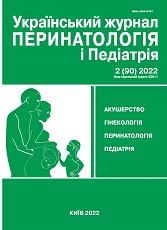Myocardial dysfunction as a component of multiple organ discrepancy with neonatal sepsis
DOI:
https://doi.org/10.15574/PP.2022.90.12Keywords:
neonates, neonatal sepsis, myocardial dysfunctionAbstract
The formation of myocardial dysfunction in neonatal sepsis remains a topical issue in current neonatal practice. Myocardial dysfunction with neonatal sepsis is found to promote a double increase of neonatal loss rate, and maintenance of an adequate cardiac output is very important predictor for survival of patients with neonatal sepsis.
Purpose - to study clinico-paraclinical markers of myocardial dysfunction in case of an alternative term of neonatal sepsis debut for timely verification and rational correction of cardiovascular disorders.
Materials and methods. Considering various terms of neonatal sepsis manifestation with its early and late variants, a comparative analysis of clinical-paraclinical markers of generalized infectious-inflammatory process was made in 26 neonates at the stage of obstetrical aid (retrospective analysis) and in the intensive care departments for neonates and their resuscitation (prospective follow-up). According to the results of the analysis of medical records of newborns, the diagnosis of early neonatal sepsis was established in 14 (53.8%) newborns who were included in the clinical group I of the study, and the diagnosis of late neonatal sepsis was established in 12 (46.2%) newborns who were included in the clinical group II.
Results. After birth general condition of patients from the group I was assessed as of moderate severity - in 1 (7.1%) and severe - in 13 (92.9%) neonates; in the group II the 2 neonates (16.7%) were in the condition of moderate severity (р>0.05) and 10 (83.3%) neonates were in severe condition (р>0.05). Assessment of cardiovascular constituent in the neonatal groups of comparison according to the constellation scale nSOFA in the means values did not differ reliably, though it was indicative of a tendency to deeper disorders in case of late neonatal sepsis.
Conclusions. Sepsis-induced myocardial dysfunction is manifested by increase in the content of cardio-specific markers (creatine phosphokinase, МВ fraction, troponin I). An increased content of troponin I in the blood higher than that of the norm in case of late neonatal sepsis possesses a high inclination (83.3%) to the formation of myocardial dysfunction.
The research was carried out in accordance with the principles of the Helsinki Declaration. The study protocol was approved by the Local Ethics Committee of the participating institution. The informed consent of the patient was obtained for conducting the studies.
No conflict of interests was declared by the authors.
References
Denning NL et al. (2020). Extracellular CIRP as an endogenous TREM-1 ligand to fuel inflammation in sepsis. JCI Insight. 5: e134172. https://doi.org/10.1172/jci.insight.134172; PMid:32027618 PMCid:PMC7141396
Denning NL, Aziz M, Diao L, Prince JM, Wang P. (2020). Targeting the eCIRP / TREM-1 interaction with small molecule inhibitor improves cardiac dysfunction in neonatal sepsis. Mol Med. 26 (1): 121. https://doi.org/10.1186/s10020-020-00243-6; PMid:33276725 PMCid:PMC7716442
Drosatos K et al. (2015). Pathophysiology of sepsis-related cardiac dysfunction: driven by inflammation, energy mismanagement, or both? Curr Heart Fail Rep. 12: 130-140. https://doi.org/10.1007/s11897-014-0247-z; PMid:25475180 PMCid:PMC4474734
Fleiss N, Coggins SA, Lewis AN, Zeigler A, Cooksey KE, Walker LA, Husain AN, de Jong BS, Wallman-Stokes A, Alrifai MW, Visser DH, Good M, Sullivan B, Polin RA, Martin CR, Wynn JL. (2021). Evaluation of the Neonatal Sequential Organ Failure Assessment and Mortality Risk in Preterm Infants With Late-Onset Infection. JAMA Netw Open. 4 (2): e2036518. https://doi.org/10.1001/jamanetworkopen.2020.36518; PMid:33538825 PMCid:PMC7862993
Gan MY, Lee WL, Yap BJ, Seethor STT, Greenberg RG, Pek JH, Tan B, Hornik CPV, Lee JH, Chong SL. (2022). Contemporary Trends in Global Mortality of Sepsis Among Young Infants Less Than 90 Days: A Systematic Review and Meta-Analysis. Front Pediatr. 10: 890767. https://doi.org/10.3389/fped.2022.890767; PMid:35722477 PMCid:PMC9204066
Lv X, Wang H. (2016). Pathophysiology of sepsis-induced myocardial dysfunction. Mil Med Res. 3: 30. https://doi.org/10.1186/s40779-016-0099-9; PMid:27708836 PMCid:PMC5037896
Martin L et al. (2016). The synthetic antimicrobial peptide 19-2.5 attenuates septic cardiomyopathy and prevents down-regulation of SERCA2 in polymicrobial sepsis. Sci Rep. 6: 37277. https://doi.org/10.1038/srep37277; PMid:27853260 PMCid:PMC5112529
Martin L et al. (2019). The septic heart: current understanding of molecular mechanisms and clinical implications. Chest. 155: 427-437. https://doi.org/10.1016/j.chest.2018.08.1037; PMid:30171861
McGovern M, Miletin J. (2018). Cardiac Output Monitoring in Preterm Infants. Front Pediatr. 6: 84. https://doi.org/10.3389/fped.2018.00084; PMid:29666787 PMCid:PMC5891589
Mironov PI, Lekmanov AU. (2021). Otsenka validnosti shkalyi nSOFA u novorozhdennyih s sepsisom. Vestnik anesteziologii i reanimatologii. 18 (2): 56-61. https://doi.org/10.21292/2078-5658-2021-18-2-56-61
Romero-Bermejo FJ, Ruiz-Bailen M, Gil-Cebrian J, Huertos-Ranchal MJ. (2011). Sepsis-induced Cardiomyopathy. Curr Cardiol Rev. 1: 163-183. https://doi.org/10.2174/157340311798220494; PMid:22758615 PMCid:PMC3263481
Sun X et al. (2015). The activation of EGFR promotes myocardial tumor necrosis factor-alpha production and cardiac failure in endotoxemia. Oncotarget. 6: 35478-35495. https://doi.org/10.18632/oncotarget.6071; PMid:26486084 PMCid:PMC4742119
Sun XQ, Abbate A, Bogaard HJ. (2017). Role of cardiac inflammation in right ventricular failure. Cardiovasc Res. 113: 1441-1452. https://doi.org/10.1093/cvr/cvx159; PMid:28957536
Wynn JL, Kelly MS, Benjamin DK et al. (2017). Timing of multiorgan dysfunction among hospitalized infants with fatal fulminant sepsis. Am J Perinatol. 34: 633-639. https://doi.org/10.1055/s-0036-1597130; PMid:27923248 PMCid:PMC5604435
Wynn JL, Polin RA. (2020). A neonatal Sequential Organ Failure Assessment score predicts mortality to late-onset sepsis in preterm very low birth weight infants. Pediatr Res. 88 (1): 85-90. https://doi.org/10.1038/s41390-019-0517-2; PMid:31394566 PMCid:PMC7007331
Downloads
Published
Issue
Section
License
Copyright (c) 2022 Ukrainian Journal of Perinatology and Pediatrics

This work is licensed under a Creative Commons Attribution-NonCommercial 4.0 International License.
The policy of the Journal “Ukrainian Journal of Perinatology and Pediatrics” is compatible with the vast majority of funders' of open access and self-archiving policies. The journal provides immediate open access route being convinced that everyone – not only scientists - can benefit from research results, and publishes articles exclusively under open access distribution, with a Creative Commons Attribution-Noncommercial 4.0 international license(СС BY-NC).
Authors transfer the copyright to the Journal “MODERN PEDIATRICS. UKRAINE” when the manuscript is accepted for publication. Authors declare that this manuscript has not been published nor is under simultaneous consideration for publication elsewhere. After publication, the articles become freely available on-line to the public.
Readers have the right to use, distribute, and reproduce articles in any medium, provided the articles and the journal are properly cited.
The use of published materials for commercial purposes is strongly prohibited.

